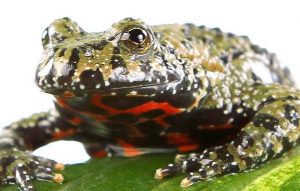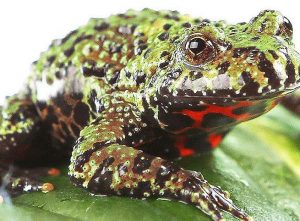The Oriental Fire-Bellied Toad (Bombina orientalis)
Looking for an amphibian pet and already have the basics of their care? Want something easy to care for and interesting to look at? Try the Oriental Fire-Bellied Toad—though it may be a challenge to find them locally, those who’ve kept them say the experience is worth it.
Not strictly a toad, this amphibian can be found in parts of Korea, China, and Russia, and is easily identified by its bright red belly.
Like all animals with warning coloration, the Oriental Fire-Bellied Toad’s belly serves to discourage predators from turning them into a not-so-tasty snack. They can even change color for camouflage to some extent, allowing them to further deter predators!

Smart predators quickly learn to fear the warning coloration because it can signify that the potential victim tastes terrible, or can cause discomfort when ingested, or worse, can be outright poisonous.
However, an Oriental Fire-Bellied Toad will usually respond by flipping themselves to reveal their fire-red bellies at any threat, an instinct known to amphibian fanciers as the “Unkenreflex” (from the German word “Unke” for the genus of fire-bellied toads).
In addition, the Oriental Fire-Bellied Toad secretes a mild toxin through its skin, which, while not fatal to humans or harmful to skin, can cause discomfort to predators—or humans who attempt to handle these creatures without washing their hands—when ingested, or transferred by touch to the eyes, where they may cause irritation or even temporary blindness.
The good news is that the animal merely secretes its toxins, and cannot squirt it. People with sensitive skin might develop rashes or mild itching, but normally, soap and water is enough to remove the secretions from human skin.
The Oriental Fire-Bellied Toad is easy to manage due to its small size, with adults reaching up to 2-2 ½ inches in length. This makes them ideal for smaller enclosures or communal tanks, and just makes them all the more adorable!
Warming Up to the Tropics
In its native temperate-zone habitat, these amphibians are known to hibernate in slow-moving waters, like ponds, puddles, and paddy fields in the forests they prefer. The ground litter in these forests provides them with bedding for hibernation, which they need to do in order to survive the colder months. From September to May, this species can be found hibernating under leaf piles, tree roots, or at the bottom of streams.

However, here in the Philippines (in captivity, that is), this species seldom hibernates, if at all! This is because ours is a tropical country, and our warmer conditions are actually more favorable for this cold-blooded species. As long as the heat does not get too extreme, the Oriental Fire-Bellied Toad is actually more active and awake in a tropical climate, which makes for an even more enjoyable pet to observe!
The Oriental Fire-Bellied Toad is adapted to the temperatures in the Philippines, so additional heating isn’t required, although lighting may be added to make it easier to view your pet. Fire-Bellied Toads are diurnal, which means they are awake during the day and asleep during the night, so a day/night cycle helps them do well.
It’s A Keeper
Keep your Oriental Fire-Bellied Toad in tanks that are mostly aquatic, like a nano tank or paludarium, and give over a fourth of the tank for moist land or cocopeat. Add a moss layer for a pleasing aesthetic touch.
Make sure the water used in the tank is dechlorinated, because like all amphibians, the skin of the Fire-Bellied Toad is permeable, and harsh chemicals can easily enter through their skin and may even poison them. Make sure that any running water in your tank is slow-moving, similar to what the Oriental Fire-Bellied Toad is accustomed to in the wild, because fast-moving water may stress your pet!
Oriental Fire-Bellied Toads are fairly active creatures, especially in our tropical climate, so if your pet suddenly becomes listless and inactive, then there may be a problem with one of your tank’s parameters, such as moisture, temperature, lighting, or humidity. It’s also possible that the hibernation instinct of your Oriental Fire Toad may have been triggered, which occurs when its living conditions become too harsh.
Food On the Go
The Oriental Fire-Bellied Toad, while not a particularly picky eater, is more easily attracted to moving food, like small insects, worms, and even mollusks. This means that their appetite is better stimulated by live food, which makes feeding time entertaining to watch, especially in communal tanks.
These amphibians have a huge appetite for their small size and can even be persuaded to take food straight from your fingers, as long as you hold your fingers some distance away from its face, rather than right up against the mouth. This also prevents the food from falling into the water, which could pollute it.
Remember to remove all uneaten food after every feeding, because polluted water can lead to infection.
Hey Girl, Come Check Out My Nuptial Pad(s)
It’s pretty easy to distinguish between male and female Oriental Fire-Bellied Toads. Males use distinctive mating calls to entice prospective mates, and their distinctive swellings on the inside of the front feet become visible. These swellings, called “nuptial pads,” are used by the males to grasp females during mating
Females, on the other hand, become more rotund as they swell up with eggs. Also, the skin of female Fire-Bellied Toads is smoother in general, although this is a less reliable way to determine the sex of a particular individual.
Males will compete with each other for females and will even injure each other, so it may be a good idea to have Toadfewer males than females in a tank, or just a single male-female pair for simplicity.
A single female can lay 3 to 45 clusters of eggs, or a full clutch size of 38 to 257 eggs! These eggs hatch into tadpoles 2 days after being laid, and careful planning may be required for prevent unwanted breeding.
It takes about a year for a newly-hatched tadpole to become an adult Fire-Bellied Toad ready for breeding, and in a tropical country, they breed over more months than in temperate countries.

Don’t Pet My Pet
If you decide to take the plunge and get an Oriental Fire-Bellied Toad as a pet, remember that they don’t like being handled, and their toxic secretions certainly discourages this. Otherwise they are very low maintenance and low cost to keep. However, some individuals have been known to live up to 20 years, so it is quite a commitment to keep one of these long-lived amphibians.
Finally, make sure you keep these critters safe in their tanks! Irresponsibly introducing this species to the local ecosystem is dangerous, especially since their toxic secretions may be fatal to other aquatic animals, so be a responsible pet owner. (Editor’s note: We’ve got more on the danger of introduced species in this issue!)
This appeared in Animal Scene’s October 2016 issue.






